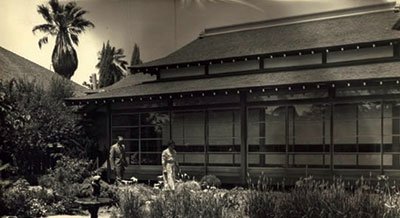It’s been called
”
the House that Garlic Built.
”
The elegant home played an important role in the
Japanese-American farming history of South Valley. Unfortunately,
it exists no more.
It’s been called “the House that Garlic Built.” The elegant home played an important role in the Japanese-American farming history of South Valley. Unfortunately, it exists no more.
On several occasions, I visited the remarkable home which stood for more than 65 years in a farm field just south of Pacheco Pass Highway. Until recently, it served as the residence of Lawson and Mineko Sakai. The saga of how the house traveled from Japan to Gilroy is as remarkable as the home itself.
The story starts in the mid-1930s when the city of San Francisco decided to put on a major festival called the Golden Gate International Exposition. This world’s fair celebrated the completion of two massive construction marvels spanning San Francisco Bay – the Golden Gate Bridge and the San Francisco-Oakland Bay Bridge.
Exposition officials invited all nations of the Pacific Rim to showcase their arts and crafts. In response, the Japanese government commissioned craftsmen of their island nation to construct an ornate pavilion. Beautiful works of Japanese arts and elaborate silk kimonos were also created and everything was shipped to the site on San Francisco Bay’s Treasure Island.
For the grand opening on Feb. 18, 1939, President Franklin D. Roosevelt sent a letter in which he praised the exposition’s purpose of bridging the people of the Pacific. Roosevelt’s correspondence proclaimed: “Unity of the Pacific nations is America’s concern and responsibility. San Francisco stands at the doorway to the sea that roars upon the shores of all these nations; and so to the Golden Gate International Exposition I gladly entrust a solemn duty. May this, America’s world’s fair on the Pacific in 1939, truly serve all nations.”
The exposition proved a monumental success. Among the most popular attractions, the Japanese Pavilion drew large crowds to view its exotic Asian culture.
All good things must eventually come to an end, however, and so did the fair. It closed its gates on Sept. 29, 1940. Soon after, workers began the sad task of tearing down the many fine buildings constructed for the expo.
Luckily, a wealthy Gilroy farmer decided it was a waste to destroy the beautifully built Japanese Pavilion. Kiyoshi “Jimmy” Hirasaki had made his fortune growing garlic and other farm products in the South Valley area. Shipping much of his garlic throughout the United States, he became nationally known has “the Garlic King.” In the 1930s, Hirasaki made garlic a major industry in Gilroy.
Lawson Sakai, Hirasaki’s son-in-law, told me how the famous farmer decided to bring the house to Gilroy. “In 1940, the fair had to dispose of everything and clean up the exhibits,” he said. “So Jimmy went up there and bought quite a few parts of the pavilion, enough parts to build his house, and he trucked it all down to Gilroy. And in early 1941, he hired six Japanese carpenters to reassemble the home on his ranch. It was assembled without nails – tongue and groove. All hand work, every piece.”
After nine months, the home was completed in autumn 1941. Two months later, the Japanese military attacked Pearl Harbor. The U.S. government quickly rounded up Japanese-American leaders they claimed threatened America’s national security. Among them was garlic farmer Hirasaki. About 120,000 Japanese-Americans living on the West Coast would also soon be placed, without due process of law, in internment camps.
Hirasaki’s boarded-up Japanese Pavilion abode stood vacant for the war’s four years. The Garlic King returned after his release expecting to see severe vandalism to the house. He found none.
“The weeds were as tall as he was in the yard,” Sakai said. “But the house wasn’t touched. Nobody had done any damage to it.”
Because of the respect Gilroy’s citizens had shown in safe-guarding his home, Hirasaki decided to remain in the South Valley area and continue farming. Eventually, his home became considered so culturally significant, Santa Clara County placed it on its historical register. In 2003, its colorful story brought it national attention on PBS’s television show “History Detectives.”
Unfortunately, in the early morning hours of Feb. 11, 2007, during a storm, the home caught fire from faulty electrical wiring. Flames quickly engulfed it. Carrying only a few mementoes, Lawson and Mineko Sakai raced out safely.
Tragically, the House that Garlic Built is gone forever. But the spirit that carried it from Japan to the South Valley lives on in our region. Japanese craftsmen built the original pavilion with pride for a world’s fair intended to bring the people of this planet together in peace. That’s something to bear in mind this weekend if you visit South Valley’s own annual “world’s fair” – the Gilroy Garlic Festival.













